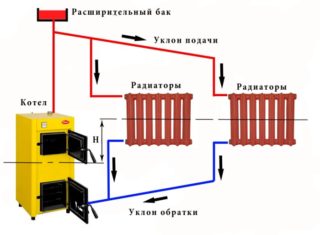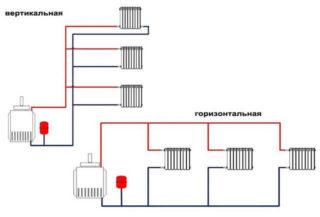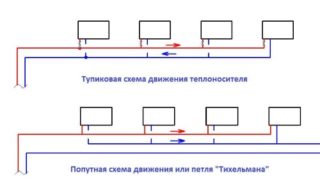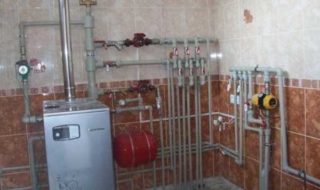Double-circuit heating is the most effective and reliable way to heat a living space. It is used in houses with different numbers of floors. Heating on two circuits from one boiler allows you to adjust the temperature in a separate room without changing the temperature in other rooms. Main feature: separation of the direct and reverse circuits of the thermal carrier. In the first case, the heated water from the boiler is supplied to the heating system, in the second, the cooled-down heat carrier is returned to the heating unit.
Main advantages
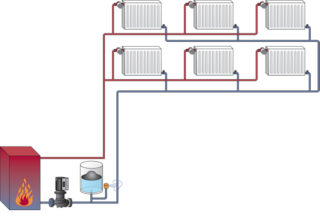
Such heating has the following advantages:
- there is no loss of coolant during supply to the radiators;
- thanks to the use of small diameter pipes, financial costs are reduced;
- the same temperature of the fluid supply to all elements of the system;
- high efficiency of the installation;
- reliability;
- You can set the temperature control on a separate battery;
- space saving due to the lack of bulky structures, which is important for small houses;
- the cost of a dual-circuit unit is much lower for the total price of a heating boiler and boiler.
The main criterion for choosing a dual-circuit device is a significant saving in space and material resources.
Construction device
The demanded double-circuit heating system in a private house can have different building schemes, but the main components remain unchanged:
- boiler for heating the coolant;
- expansion tank to replenish the amount of water during its heating;
- pumping unit for circulating hot liquid along the contours;
- radiators, through which heat is effectively transferred to the heated room;
- control elements.
The double-circuit heating system provides the house with hot water and heat from a single source. Installing a circulating pump significantly increases the efficiency of the utility network.
In a two-circuit system device, it is possible to use a single-circuit boiler, if a boiler with indirect heating is connected to the latter.
Varieties of dual-circuit heating systems
Since many two-pipe heating systems are used, each of which has its own characteristics, it is worth understanding the basic schemes.
Horizontal and vertical
The type of layout is determined based on the installation method of a dual-circuit heating installation.
The vertical scheme is better suited for structures of several floors, the horizontal one is for single-storey buildings of a huge area.
In the installation of the first there is a certain number of individual risers and batteries. In the other there is one or two risers, as well as several heating sources with a location on the same level.
Lower and upper wiring
An important distinguishing feature is the location of the tank and the unit for heating. In the case of the upper wiring, they are placed under the roof of the structure, with the lower - in the basement.
Systems with passing and oncoming water movement
In the first, the heated fluid in both circuits has the same direction of motion. In others, cold water flows from the opposite side, when compared with the direction of movement from the boiler.In such a design, there is a final radiator, where the 2 most distant points are connected.
With natural and forced circulation
The movement of the thermal carrier occurs under the influence of the temperature difference in the contours of structures with a natural cycle. Water in this case heats up slowly, but there is no need to install a pump. In systems with forced circulation, a pump is mounted on one circuit, the operation of which drives the coolant. Thanks to this popular design, heat is evenly distributed throughout the building.
Calculation of boiler power and boiler capacity
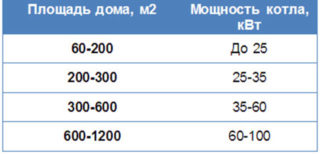
With the correct power of the heating unit in the combustion chamber, the temperature will not rise above 90 ° C, which significantly increases the service life of the equipment.
The easiest calculation method:
Q = S × A × k
- Q - thermal power (watts);
- S - internal area of the structure (m²);
- A - the number of watts of the total capacity of the heating system per 1 m² (as a rule, 100 - 150 watts);
- k - safety factor for severe cooling (1.2 or 1.25).
If the total area of the heated room is about 100 m2, the maximum power cannot exceed 38 kW. On a boiler, as a rule, two values indicate. The first shows the energy consumption in heating mode, the second shows the power for fast heating of water.
The boiler capacity must be calculated based on future consumption: an average of 10 liters for washing dishes, 30 liters for taking a shower, 100 liters for a bath and a large wash.
Preparatory work
The troublesome installation of a dual-circuit heating system usually begins with complex hydraulic calculations. It is practically impossible to do this in-house on their own. Therefore, it is recommended to turn to professionals: they can take into account all the nuances and features of the structure in which it is necessary to install heating equipment. A correctly selected heating scheme for a private house with a gas double-circuit boiler will provide in the future a more economical use of resources for heating.
A competent calculation will help you choose the best structural solution for the construction, the number of components that will certainly be required to connect the heating system.
Equipment installation
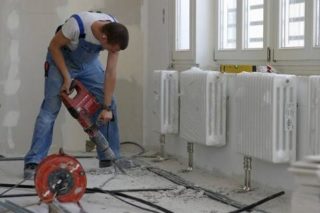
Installation of a contour heating system consists of successive stages. Their implementation should be approached responsibly so as not to disrupt the final design.
- A heating boiler and the upper part of the circuit are installed, the purpose of the latter is to supply coolant to the radiators.
- Installation of the tank with small taps to remove water, pipe.
- A main line with batteries is drawn through the rooms.
- If necessary, a pump crashes to ensure circulation in the return circuit.
It is better to connect radiators that have small taps at the inlet and outlet. This nuance will allow the batteries to function offline, as well as to repair an individual element without shutting down the system installation.
After the connection is completed, the equipment is carefully inspected for defects and clutch reliability.
Natural gas is considered the best fuel, but its use requires the observance of certain rules so that it does not cause a danger.
Modern appliances are equipped with automation, which controls the level of heating, maintains the desired temperature.
